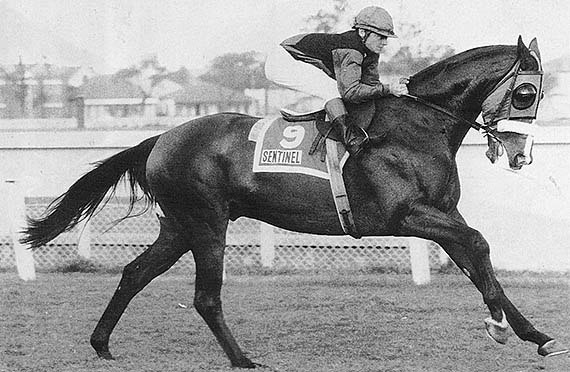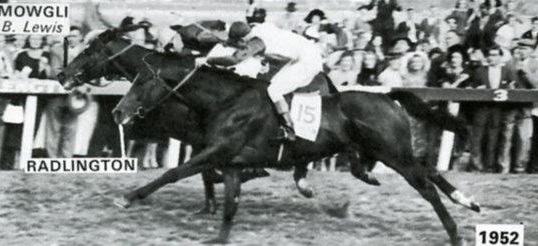Moira Ellis was a wonderful, regal lady; with her magnanimous generosity of spirit, she was always a welcoming hostess at the old Hartford, where the Ellises presided over one of the greatest stories in South African thoroughbred history, writes Mick Goss.

Mick Goss
The Ellis breeding dynasty was described by the famous author Sir Mordaunt Milner as ranking alongside those of the great thoroughbred breeders of the era, including England’s Lord Derby and Aga Khan,America’s Claiborne and Calumet Farms, France’s Marcel Boussac and Italy’s Senor Tesio.
That’s what we would call “being bred in thoroughbred purple”.
The Ellises had bred, raised and trained on the Hartford property, the winners of every major race on the South African calendar.

Sentinel – a legend of the turf
The paddock alongside the chapel bore the footprints of the legends Mowgli, Sentinel and Magic Mirror. And Cape Heath, Panjandrum, Alyssum, Magic Charm, Ajax and Salmon.

Mowgli wins the 1952 Durban July – a finish marked as the most exciting by legendary race-caller Ernie Duffield.
The roll call is long, and proof of Sir Mordaunt Milner’s proclamation that the Ellis era remains unrivalled in its dominance to this day.
I remember the first time I entered the sandstone gates of Hartford.
Along the drive, the old flower pots bearing the names of forty eight champions, talked of a fading history; things were quieter these days, but I knew I’d arrived in the racehorse valhallah.
The Hartford horses had infused the Ellises with the divinity of a racing pope.

Hidden away from the mortal world behind those great gates was the “great within”, as this imperial enclave was affectionately known. Raymond Ellis’ aura radiated outward with the mystery and power of any enthroned Holy Father.
He set records in racing the way Jacques Kallis has done in cricket.

He changed the way horses were trained, as surely as Mohammed Ali changed the way men moved in a boxing ring.
He even contrived to ruin a stereotype.
Because of the man he was, he brought a wholesomeness to a game that suffered from an ancient occupational hazard: no man blames himself when he’s “done” the housekeeping cash on a horse.
While other horsemen of the time occasionally won big races, they often seemed to be throwing a dice and praying a lot. Ellis on the other hand, always seemed to be working to some guaranteed quota.
Since the outbreak of World War II, the Ellises had carried the mantle of greatness into other realms, none greater though, than the fortress they built around the stock of Sybil’s Nephew and Masham.
There was a time, from the forties through the seventies, when a horse in the green and black on its way to post, was said to be better than money in the bank.
I have to confess, I liked the poetry, but it only heightened my apprehension at the time.
So here we were, the boy from Pondoland and the girl without a “school-leavers”, venturing into the unknown of 1989.

Giant’s Castle – breathtaking
Luckily, Hartford is more than great “dirt”: abundant valleys of gorgeous loam over sandstone and basalt, hundreds of massive blue gums and oaks telling you the country is kind, but not soft.
With its chapel, its venerable homestead and its English gardens, Hartford is a national institution.
When Graham Ellis handed me the keys to the house in the shadow of Verrocchio’s masterpiece, I had a sense of destiny.

He was obviously moved, but that’s okay: he hid it behind his sunglasses.
I promised we’d do all we could to honour the past, whatever that took.

When the Summerhill team lined up for its ninth consecutive Breeders’ premiership in the spring of 2013, I sensed the old man was saying “mission accomplished”.
A memorial service was held in Moira’s honour last Friday at Highbury School Chapel at Hillcrest .
She will be remembered with fondness by all at Summerhill who had the pleasure of meeting her.








